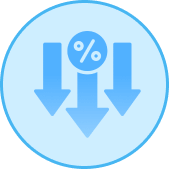For centuries, Indian agriculture has thrived on the dedication of farmers. With the advancement in modern tools, the tractor has become a versatile machine that offers the potential to revolutionize farming practices, but its significant cost can pose a significant challenge.
Tractor loans in India bridge this gap, providing farmers with a much-needed financial bridge to acquire this crucial equipment.
What are Tractor Loans?
Tractor loans are a type of financing specifically designed to help farmers purchase tractors. By spreading the cost over a manageable loan term, they enable farmers to get the essential machinery without depleting their resources. A tractor loan is also an investment since it helps farmers in long-term productivity and income improvements.
Tractor Loan Interest Rates
Tractor loan interest rates are key players in agricultural financing. Much like how a tractor fuels farming efficiency, understanding interest rates empowers farmers to make good financial choices.
The table below shows the general interest rate offered for tractor loans:
| Tractor Loan Interest Rate | Starting from 9% p.a. |
Tractor Loan Eligibility
While tractor loans have the power to progress in Indian agriculture, securing one requires meeting specific eligibility criteria. Understanding these requirements is crucial for a smooth application process and maximizing your chances of approval. Here's a breakdown:
- Age: Typically 18 to 65 years old.
- Citizenship: Proof of Indian citizenship or residency might be required.
- Identity and Address Proof: PAN card, Aadhaar card, voter ID card, driving license, etc.
- Income Proof: Documentation demonstrating your income sources is essential. This can include land ownership documents showcasing agricultural income, recent salary slips, ITRs, or proof of other income streams like freelance work or rentals.
- Collateral: Pledging assets like land, property, or existing assets can strengthen your application and potentially lower interest rates.
- Guarantors: Providing a guarantor with a stable income can enhance your eligibility, especially for first-time borrowers or those with limited credit history.
- Credit Score: A good credit history significantly improves your eligibility and potentially opens doors to lower interest rates.
- Purpose of Loan: Some lenders offer specific loan options with tailored eligibility criteria for purposes like fruit cultivation, poultry farming, or dairy farming.
Tractor Loan EMI Calculation
Calculating your tractor loan EMI (Equated Monthly Installment) is crucial for determining affordability and planning your loan repayments. Here's how you can do it:
1. Using the Buddy Loan EMI calculator:
2. Using the formula to calculate:
To calculate the loan EMI manually you can use the following formula:
EMI = P * R * ((1+R)N/(1+R)N- 1)
Where,
EMI is the equated monthly installment.
P is the principal amount.
R is the interest rate.
N is the loan tenure.
This is how you use this formula-
For example, let's say you take a loan of ₹5,00,000 with an interest rate of 10% for 5 years. Using the formula, your EMI would be:
P = Rs 5,00,000.
R = 10%/ 12, i.e., = 0.1/ 12 = 0.00833 (approx)
N (in months) = 60
Now using the formula;
EMI= 5,00,0000 * 00833 * ((1+0.00833 )60/(1+0.00833 )60- 1)
EMI= 5,00,0000 * 00833 *(1.64490/0.6449)
Your monthly EMI will be around Rs 10,624
Document Required for Tractor Loan
The documents required for a tractor loan in India can vary depending on the lender, your specific situation, and the type of loan you're applying for. However, here's a general overview of the common documents you'll likely need:
Basic Documents:
- Application Form: The lender will provide you with a form to fill out your details and loan requirements.
- Identity Proof: PAN card, Aadhaar card, voter ID card, driving license, etc.
- Address Proof: Ration card, utility bills, bank statements, etc.
Documents for Proof of Income:
- Land Ownership Documents: If you own agricultural land, provide documents like land registry, title deeds, or khata extracts.
- Income Tax Returns (ITRs): For the past few years, if applicable.
- Salary Slips: Recent salary slips if employed.
- Proof of other income sources: Documents showcasing income from rentals, investments, freelance work, etc.
Features & Benefits of Tractor Loan
Tractor loans provide several crucial features and benefits for farmers, providing access to modern equipment with flexible repayment options and more. Here are a few of them:

Fast and Convenient
Get loans disbursed faster

Competitive Interest Rate
Get affordable interest
rates starting at 9% p.a.

Zero Collateral
Get your tractor with zero
collateral
Secured loan
Minimises risk and get
loans that are flexible

Flexible Repayment
Get repayment tenure up to
7 years
Government Schemes
Some schemes offer
subsidies, lower interest
rates, or easier eligibility.
Government Schemes for Tractor Loan
The Indian government recognizes the pivotal role tractor loans play in empowering farmers and boosting agricultural productivity. To make these essential machines more accessible, several government schemes offer subsidized interest rates and flexible repayment options for tractor loans. Here's a summary of some key schemes:
1. Pradhan Mantri Kisan Tractor Yojana (PMKTY):
- Launched in 2021, PMKTY provides a 50% subsidy on tractor loan interest rates for small and marginal farmers
- Implemented by the state governments, it focuses on specific tractor models with horsepower ranging from 18 HP to 49 HP.
2. Sub-Mission on Agricultural Mechanization (SMAM):
- Part of the National Agricultural Development Programme, SMAM offers financial assistance for farm mechanization.
- While not directly providing tractor loan subsidies, the scheme supports capacity building, training, and awareness creation about farm machinery, including tractors.
- This indirect support empowers farmers to make informed decisions and potentially qualify for better loan terms from banks or NBFCs.
3. NABARD (National Bank for Agriculture and Rural Development) Loans:
- While not a specific scheme, NABARD, a government-owned institution, plays a crucial role in facilitating agricultural financing.
- NABARD offers various loan schemes for farm mechanization, including tractor loans, often with lower interest rates compared to commercial banks.
- Partnering with banks and cooperatives, NABARD helps make financing options more accessible to farmers in rural areas.
4. PMEGP stands for Prime Minister's Employment Generation Programme.
- It's a major credit-linked subsidy scheme launched by the Government of India to promote self-employment opportunities in the non-farm sector, primarily focusing on rural and urban areas.
- Individuals above 18 with viable business ideas in industries like manufacturing, services, or village industries can benefit from subsidies up to 40% and loan assistance.
How to Apply for Tractor Loan
- Assess your needs: Consider the type of tractor you need, consider the horsepower, features, and brand based on your farm size and specific requirements. You may also think about the loan amount you need and estimate the cost of the tractor and any additional equipment you might require.
- Compare loan options: Research different banks, financial institutions, and even tractor manufacturers that might offer tractor loans. Compare interest rates, fees, and repayment terms. Lower rates and choose the best option for your needs.
- Check eligibility criteria: Some lenders might have specific requirements like minimum land ownership or credit score.
- Gather documents: Get the necessary documents required for the loan, it could be proof of identity and address or proof of income and other documents as specified by the lender.
- Apply for the loan: Choose your preferred lender and submit the required documents online or in person at a branch.
- Await loan approval: The lender will review your application and documents. This might take a few days to a few weeks. If approved, you will receive a loan offer outlining the terms and conditions.
- Accept the offer and finalize the loan: Once you accept the offer, sign the loan agreement and provide any additional documentation required. The loan amount will be disbursed to you or directly to the tractor dealer, depending on the agreement.
Frequently Asked Questions
Indian farmers can secure a tractor loan by choosing a lender, assessing tractor needs, estimating the loan amount, applying online or in-person, completing credit evaluation, accepting terms, and ensuring timely repayments.
Several banks, financial institutions, and even tractor manufacturers offer loans specifically for purchasing used tractors. These loans come with competitive interest rates, flexible repayment terms, and minimal documentation requirements.
Proof of identity, address, income, land ownership, and tractor purchase quotes are typically required for a new tractor loan.
Tractor loans fall under both agricultural loans due to their purpose and secured loans because the tractor serves as collateral.
Interest rates on tractor loans can vary from 9.00% to 23.26% p.a., depending on factors like your credit score, loan amount, tenure, and lender.
While the exact credit score requirements for tractor financing can vary between lenders, generally, a score of 680 or above is considered good enough for approval. However, the number can change depending on different lenders.
Minimum and maximum tractor loan amounts in India can vary based on the lender, your creditworthiness, and the tractor's value.
Tractor loans are secured agricultural loans specifically for acquiring tractors, differing from other agricultural loans by focusing on a single, high-value equipment purchase.
Your creditworthiness, land ownership, income level, and chosen tractor's value are key factors determining tractor loan eligibility. Remember that these factors can be different based on lenders
Tractor loan interest rates can be fixed or variable, with rates dependent on factors like credit score, loan amount, tenure, and lender policies.
Tractor loans typically cover a wide range, from basic models for small farms to high-powered tractors for large-scale operations, as long as the model falls within the lender's age and value limitations.
Typical tractor loan repayment periods range from 3 to 7 years, though some lenders might offer longer tenures depending on loan amount and borrower profile.
Defaulting on tractor loan payments can lead to late fees, interest penalties, legal action, and even repossession of the tractor.
Yes, several Indian government programs like Pradhan Mantri Kisan Tractor Yojana offer subsidies, lower interest rates, or easier eligibility terms to make tractor loans more accessible to farmers.
Yes, in many cases, a tractor loan can be used for both personal and commercial farming purposes. While the specific terms and conditions may vary depending on the lender, many recognize that farms often blend personal and commercial activities.
Display of trademarks, trade names, logos, and other subject matters of Intellectual Property displayed on this website belongs to their respective intellectual property owners & is not owned by Bvalue Services Pvt. Ltd. Display of such Intellectual Property and related product information does not imply Bvalue Services Pvt. Ltd company’s partnership with the owner of the Intellectual Property or proprietor of such products.
Please read the Terms & Conditions carefully as deemed & proceed at your own discretion.




 Rated 4.5 on Google Play
Rated 4.5 on Google Play 10M+ App Installs
10M+ App Installs 25M+ Applicants till date & growing
25M+ Applicants till date & growing 150K+ Daily Active Users
150K+ Daily Active Users
